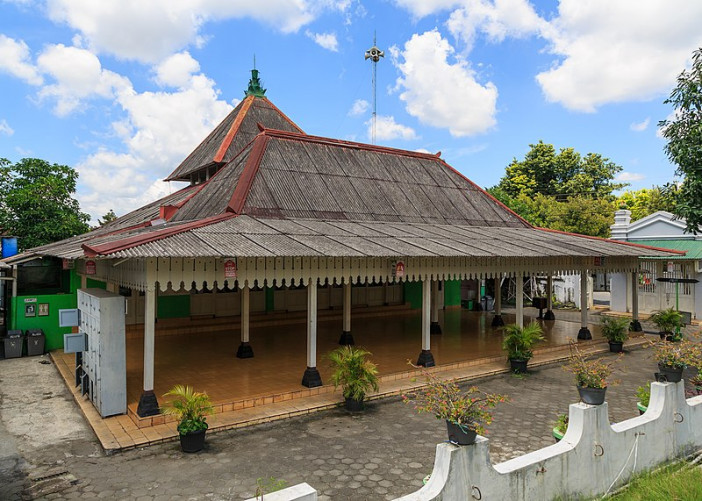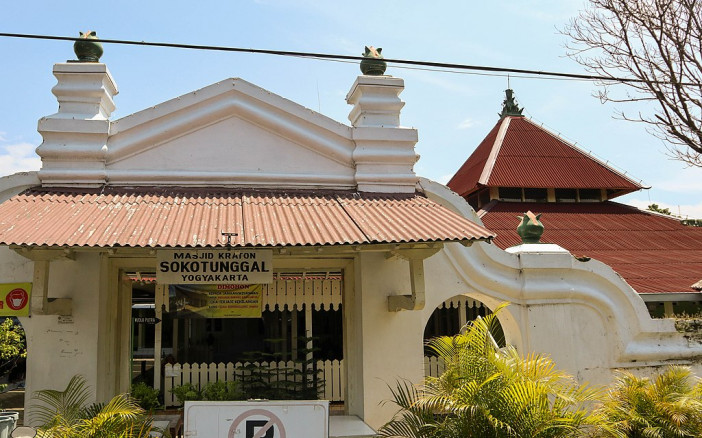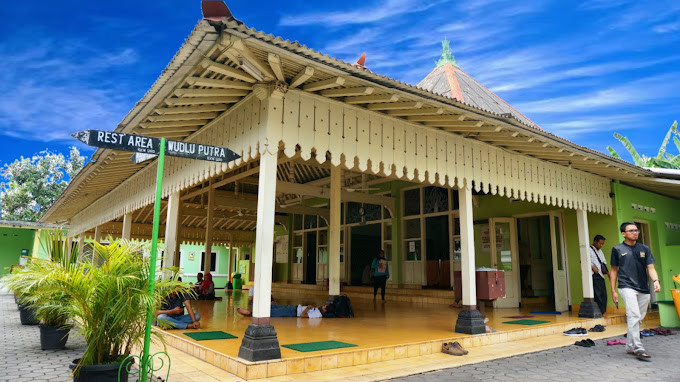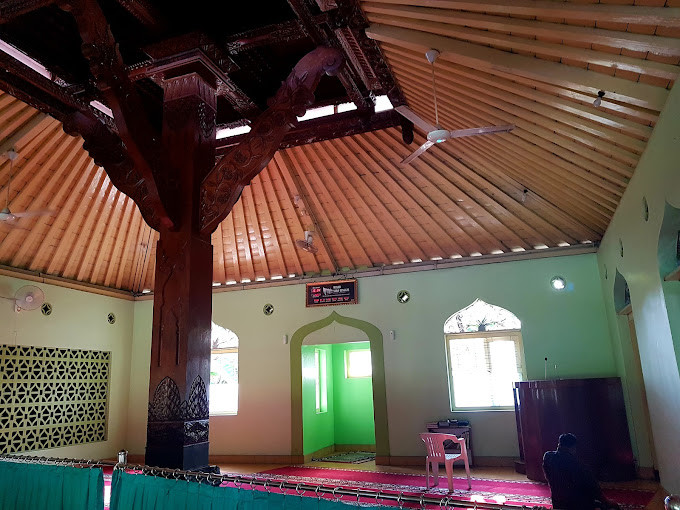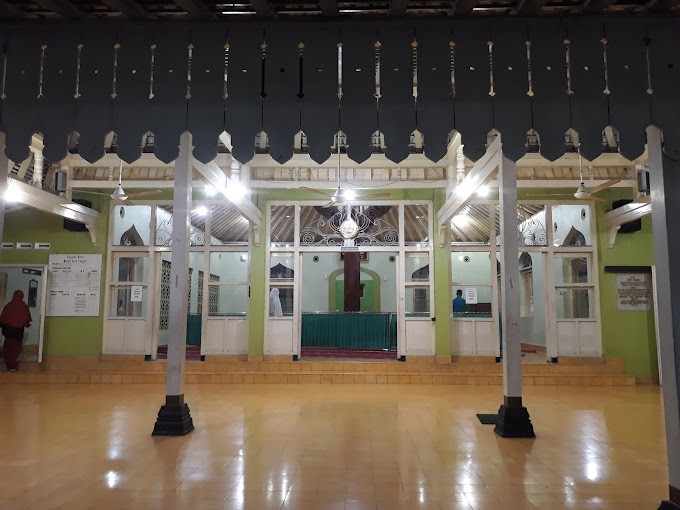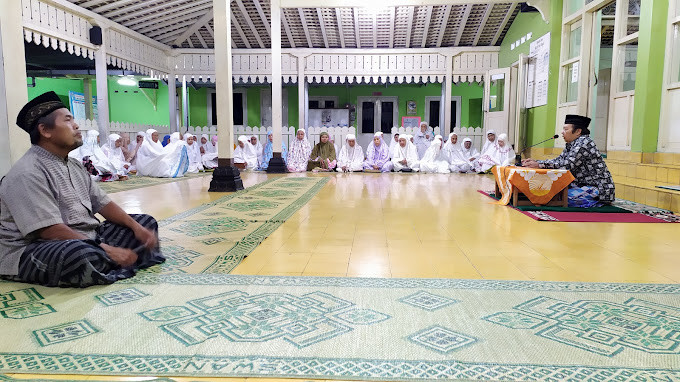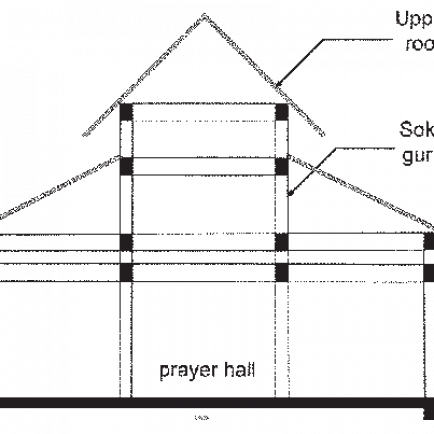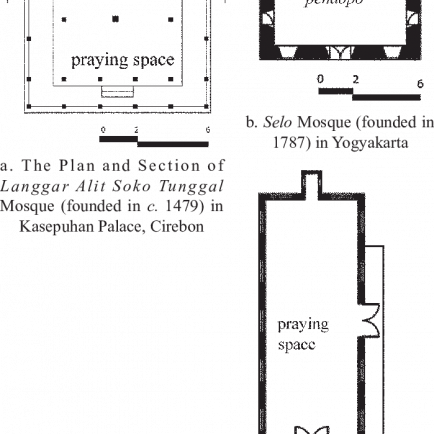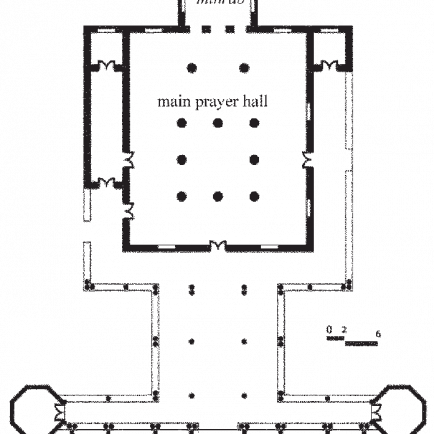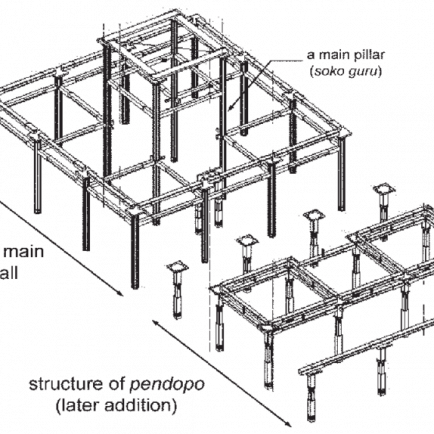Soko Tunggal Mosque
History
According to the inscription on the front wall, the Soko Tunggal Mosque was inaugurated on Wednesday Pon , 28 February 1973 by Sri Sultan Hamengkubuwono IX . The construction of this mosque was completed on Friday Pon , the 21st of Rajab in the year Be and is marked with the candrasengkala "Hanembah Trus Gunaning Janma" 1392 H or September 1 with the Suryasengkala "Nayana Resi Anggatra Gusti" 1972 AD.
Urban and Architectural
Planners and basic forms
The designer of the Soko Tunggal Mosque was R. Ngabehi Mintobudoyo ( deceased ) who was the last architect of the Yogyakarta Palace .
The design of this building is in the form of a tajug , with one pillar (single saka) measuring 50 cm x 50 cm which is located in the middle of the room.
Symbolic meaning
The architecture of this mosque building is full of meaning. If the congregation sits in the room of the mosque, they will see 4 saka bentung stems and 1 saka guru stem, so that there are 5 in total. This is the national symbol of Pancasila. Saka guru is a symbol of the first precepts, namely: Belief in the One God. Uusuk sorot (concentrated like the spokes of an umbrella), also called peniung , is a symbol of the authority of the state which protects its people.
In this mosque there are also various carvings. This carving is not only intended to add beauty and dignity, but also contains a specific meaning and purpose.
Praba carving , means Earth, land, authority. Saton carving means solitude, sawiji . Highlight means a ray of sunlight. Tlacapan means panggah , that is steadfast and tough. Ceplok means the eradication of anger. Mirong carving means maejan or tombstone, meaning that all will be called by God. The carving of dew drops between the leaves and flowers on the rolling pin means that those who pray in this mosque may receive God's grace.
From the construction aspect, the Sokotunggal mosque building is also full of meaning. In the construction of the mosque there is a part that is in the form of a bahu danyang' . This symbolizes that those who pray in this mosque will become strong people in facing the temptations of the demons of anger and wrath that come from the four directions and five pancers . Sunduk means creeping to reach the goal. Santen means clean and holy (honesty). Uleng means authority. Singup means sacred, Bandoga means tree decorations, treasure places. Tawonan means gana , sweet, full.
The framework of the mosque formed in such a way also has a meaning. Saka brunjung symbolizes the effort to achieve the nobility of authority through the wasp symbol . Dudur is a symbol towards the ideal of perfection in life through the symbol of cannabis . Mace head , symbolizing the perfection of a powerful weapon, perfect both physically and spiritually. Mustaka is used to symbolize nobility and authority.
Description
The Soko Tunggal Mosque is a mosque located in the Kraton City of Yogyakarta, Pate Sub- District , Yogyakarta . Located in the Njeron Beteng Kraton Yogyakarta area , this mosque is right in front of the entrance to the Tamansari tourist attraction . The name "Soko Tunggal" comes from two words, namely "Soko" which means support or pillar, and "Tunggal" which means one. So literally, Soko Tunggal means one pillar. This name is used because this mosque only has one main pillar.
References
https://id.wikipedia.org/wiki/Masjid_Soko_Tunggal
https://www.researchgate.net/figure/Axonometri-of-the-Javanese-Mosque-Structure-Original-Drawing-by-M-Ichsan-Modified-by_fig3_245440760
Details
Location
Yogyakarta City , Yogyakarta , Indonesia
Worshippers
600
Owners
Indonesian Mosque Council
Architect Name
Year of Build
1967
Area
1000
Drawings
Map
History
According to the inscription on the front wall, the Soko Tunggal Mosque was inaugurated on Wednesday Pon , 28 February 1973 by Sri Sultan Hamengkubuwono IX . The construction of this mosque was completed on Friday Pon , the 21st of Rajab in the year Be and is marked with the candrasengkala "Hanembah Trus Gunaning Janma" 1392 H or September 1 with the Suryasengkala "Nayana Resi Anggatra Gusti" 1972 AD.
Urban and Architectural
Planners and basic forms
The designer of the Soko Tunggal Mosque was R. Ngabehi Mintobudoyo ( deceased ) who was the last architect of the Yogyakarta Palace .
The design of this building is in the form of a tajug , with one pillar (single saka) measuring 50 cm x 50 cm which is located in the middle of the room.
Symbolic meaning
The architecture of this mosque building is full of meaning. If the congregation sits in the room of the mosque, they will see 4 saka bentung stems and 1 saka guru stem, so that there are 5 in total. This is the national symbol of Pancasila. Saka guru is a symbol of the first precepts, namely: Belief in the One God. Uusuk sorot (concentrated like the spokes of an umbrella), also called peniung , is a symbol of the authority of the state which protects its people.
In this mosque there are also various carvings. This carving is not only intended to add beauty and dignity, but also contains a specific meaning and purpose.
Praba carving , means Earth, land, authority. Saton carving means solitude, sawiji . Highlight means a ray of sunlight. Tlacapan means panggah , that is steadfast and tough. Ceplok means the eradication of anger. Mirong carving means maejan or tombstone, meaning that all will be called by God. The carving of dew drops between the leaves and flowers on the rolling pin means that those who pray in this mosque may receive God's grace.
From the construction aspect, the Sokotunggal mosque building is also full of meaning. In the construction of the mosque there is a part that is in the form of a bahu danyang' . This symbolizes that those who pray in this mosque will become strong people in facing the temptations of the demons of anger and wrath that come from the four directions and five pancers . Sunduk means creeping to reach the goal. Santen means clean and holy (honesty). Uleng means authority. Singup means sacred, Bandoga means tree decorations, treasure places. Tawonan means gana , sweet, full.
The framework of the mosque formed in such a way also has a meaning. Saka brunjung symbolizes the effort to achieve the nobility of authority through the wasp symbol . Dudur is a symbol towards the ideal of perfection in life through the symbol of cannabis . Mace head , symbolizing the perfection of a powerful weapon, perfect both physically and spiritually. Mustaka is used to symbolize nobility and authority.
Description
The Soko Tunggal Mosque is a mosque located in the Kraton City of Yogyakarta, Pate Sub- District , Yogyakarta . Located in the Njeron Beteng Kraton Yogyakarta area , this mosque is right in front of the entrance to the Tamansari tourist attraction . The name "Soko Tunggal" comes from two words, namely "Soko" which means support or pillar, and "Tunggal" which means one. So literally, Soko Tunggal means one pillar. This name is used because this mosque only has one main pillar.


